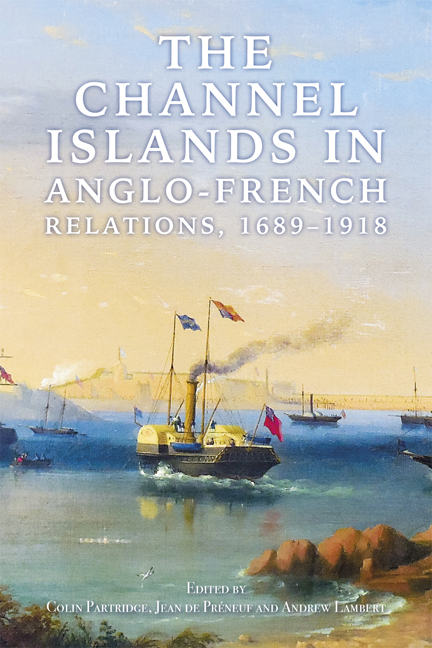Book contents
- Frontmatter
- Dedication
- Contents
- List of Illustrations
- List of Contributors
- Preface
- Introduction: ‘The Ehrenbreitstein of the English Channel’
- Part 1 Corsairs – the Ancien Régime and French Wars from 1689
- Part 2 The Islands – French and British Intelligence from the Seven Years War to 1815
- Part 3 Territorial Waters – the Land and Sea Interface from the 17th to 20th Centuries
- Part 4 Engineering Strategic Change
- Part 5 Alderney and the Channel Islands – Naval Strategy from 1815 to 1905
- Part 6 Civil Societies and Anglo-French Naval Rivalry – the 19th Century to WWI
- Part 7 Trade War – the Protection of Channel Islands Shipping in the Great War
- Afterword: Alderney, The Channel Islands, and the Study of History
- Bibliography
- Index
12 - Royal Navy Trade Defence in the English Channel During the First World War
Published online by Cambridge University Press: 15 May 2024
- Frontmatter
- Dedication
- Contents
- List of Illustrations
- List of Contributors
- Preface
- Introduction: ‘The Ehrenbreitstein of the English Channel’
- Part 1 Corsairs – the Ancien Régime and French Wars from 1689
- Part 2 The Islands – French and British Intelligence from the Seven Years War to 1815
- Part 3 Territorial Waters – the Land and Sea Interface from the 17th to 20th Centuries
- Part 4 Engineering Strategic Change
- Part 5 Alderney and the Channel Islands – Naval Strategy from 1815 to 1905
- Part 6 Civil Societies and Anglo-French Naval Rivalry – the 19th Century to WWI
- Part 7 Trade War – the Protection of Channel Islands Shipping in the Great War
- Afterword: Alderney, The Channel Islands, and the Study of History
- Bibliography
- Index
Summary
Introduction
The primary role of the Royal Navy in the First World War was to protect seaborne commerce and communications, and there was no greater challenge to the flow of oceanic trade than Germany's unrestricted submarine campaign of 1917–18. Since the wars with Louis XIV the protection of trade had been critical to England's national survival, with the Western Approaches and English Channel the decisive maritime theatres. William III crossed the English Channel at the beginning of the War of the League of Augsburg, and the privations of Spanish, Dutch and French commerce raiders during the War of Spanish Succession were so significant that the newly created United Kingdom was forced to introduce compulsory convoys in 1707. The defence of trade was no less significant for the conduct of distant colonial campaigns during the Seven Years War, and the protection of merchant shipping necessitated a strict convoy policy during the American Revolutionary War. The Act of 1798 once again granted the Admiralty the power to enforce the convoy system on oceanic merchants, and indeed it was control of these vast supply lines, and the mobilization of capital and credit this enabled, that contributed so profoundly to victory against Napoleon's Empire.
The legal basis for the protection of oceanic trade, and the rules of engagement for maritime warfare, became codified during what Stephen Cobb described as the new ‘liberal age of free trade’ that emerged in the decades following the Congress of Vienna. Privateering was abolished by the 1856 Declaration of Paris and the rights of neutrals during a naval blockade reinforced by the 1907 Hague Conference and the 1909 Declaration of London. Warships engaged in trade interdiction were expected to follow prize law, necessitating basic consideration for the crews of captured ships and assuring the safety of passengers.6 By 1914 the Royal Navy's conceptualization of trade defence had transitioned from the traditional 18th century combination of convoy escort and close blockade to a geographically globalized laissez-faire model that provided for the security of oceanic communications and trade routes through command of the sea.
- Type
- Chapter
- Information
- The Channel Islands in Anglo-French Relations, 1689-1918 , pp. 234 - 258Publisher: Boydell & BrewerPrint publication year: 2024



